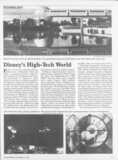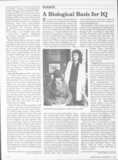

Epcot. It was to be a fantasist's fantasy come true, a Disneyland where real people – not paying tourists – would live, work and play in an Experimental Prototype Community of Tomorrow. There would be no crime, no pollution, no filth in this high-tech utopia, and the 20,000 Epcotians in the enclosed city would be served by only the latest technological wonders mankind could produce. In the early 1960s Walt Disney roamed central Florida looking for a site to build his utopia: he registered in local motels as "Bill Davis' and secretly bought up nearly 30,000 acres. But Disney died before he had a chance to make his vision a reality, and the dream of a technology utopia died with him. "Maybe he could have made it work," says Disney senior vice president Jack B. Lindquist, "but we wrestled with it for years and couldn't see how."
So Disney's heirs resorted to a more familiar formula, pioneered by Walt 27 years ago. Epcot was transformed into $900 million futuristic theme park, complete with a giant 18-story silvery geodesic dome Spaceship Earth-looming over sprawling 260-acre complex of technology pavilions and a "World Showcase" featuring model of the top of the Eiffel Tower and other reconstructed landmarks from nine countries. Mickey Mouse and Donald Duck have been banished to the souvenir shops; instead Epcot visitors are feted by a host of new creatures. In "The Land" pavilion – featuring the world of high-tech agriculture – visitors are treated to the robot Cereal Sisters (Connie Corn, Mairzy Oats and Rennie Rice) singing "The Boogie Woogie Bak'ry Boy, the Toast of the Town."
[…]